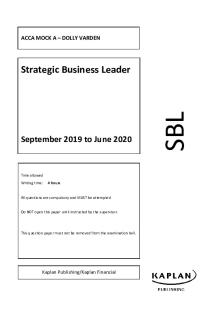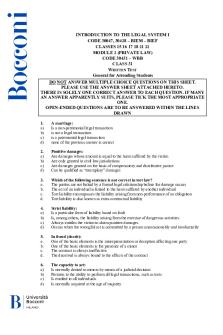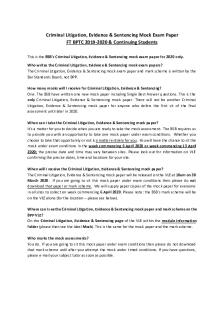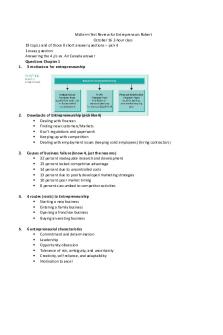PASS BIOL 1001 Winter 2020 Mock Test 1 PDF

| Title | PASS BIOL 1001 Winter 2020 Mock Test 1 |
|---|---|
| Author | Sam Johnson |
| Course | Biology II - Evolution, Ecology, Biodiversity and Conservation Biology |
| Institution | York University |
| Pages | 9 |
| File Size | 351.2 KB |
| File Type | |
| Total Downloads | 44 |
| Total Views | 521 |
Summary
Download PASS BIOL 1001 Winter 2020 Mock Test 1 PDF
Description
PASS BIOL 1001 MOCK TEST #1 WINTER 2020 Weekly sessions held on Monday 2:30 BC 202 Thursday 1:00 BC 202 PASS Leader: Emily Anacleto
Please note: Do not substitute this mock test for studying. The questions included are only examples of what may appear on the midterm and are not necessarily representative of the degree of difficulty. This test is copyright of the PASS program at Bethune College.
For more information visit bethune.yorku.ca/pass and join the Facebook group PASS BIOL 1001 WINTER 2020
1. Which of the following is typical to the concept of a hypothesis, in a scientific context? a. An explanation of some natural pattern by a process, a mechanism that produces a pattern b. Generally well-tested and supported c. An observation or descriptive measurement d. An inference derived on the basis of reasoning and evidence e. A testable prediction of some observation that can be repeatedly tested 2. When testing for the causes of ulcers, no evidence was found to support the excess acid hypothesis. What does this mean regarding the alternative hypothesis that bacteria cause ulcers? a. The hypothesis is more likely b. The hypothesis is less likely c. The hypothesis is not more or less likely d. The hypothesis is proven correct 3. Which of the following statements is false? a. Microevolution makes every member of a species in a population adapt to their environment b. Evolution always leads to the creation of new species c. Natural Selection leads to complexity in body form d. None of the above (a-c) are false e. All of the above (a-c) are false 4. Which of the following is NOT a type of fossil bias? a. Abundance bias b. Taxonomic bias c. Temperature bias d. Habitat bias
5. On the diagram above, which node is the most recent common ancestor of primates and ray-fined fish? a. A
b. c. d. e. f.
B C D E F
6. On the diagram for the previous question, where would the trait for individual fingers have to arise for it to be homologous for crocodiles and amphibians? a. A b. B c. C d. D e. E f. F 7. Which of these are not a type of homology? a. Developmental b. Genetic c. Location d. Structural 8. (Dr. Mills section only) An igneous rock was found with a ratio of 1:15 Uranium to Lead isotopes. If the decay of Uranium to Lead has a half life of 12000 years, how many years old is the rock? a. 12000 b. 24000 c. 36000 d. 48000 e. 60000 9. What is the true definition of structural homology? a. The structure was present in a common ancestor and is present in a modified state b. That a structure confers fitness and is passed on to its offspring c. The structures have the same function or appearance d. That the structure arose in different species because it is useful 10. What is a transitional fossil? a. A fossil still being made b. A fossil that is found in many different areas c. A fossil that links an older species with a younger species d. A fossil that shows how an individual is changing into a different species 11. Which of the following locations would be more likely to produce a fossil if an organism died within it?
a. Swamp b. Desert c. Mountain d. River 12. Which of the following results in vestigial traits? a. The organism stopped using the feature, so it grew smaller and weaker b. The feature no longer grants selective advantage, so it is no longer selected for c. The population no longer needed the feature, so it was no longer produced d. The features degraded by chance through random natural selection 13. What is the major difference between absolute and relative dating? a. Absolute dating directly measures the date of a rock layer b. Relative dating does not utilize radiometric dating at all c. Absolute dating cannot date organic fossils d. Relative dating involves dating sedimentary rock 14. You go out fossil hunting inspired by all the talk of fossils in class to find some of your own. Amazingly due to your skill you find a fossil in your backyard ravine! Based on where you found the fossil, what would you assume about the fossil? a. It will be dinosaur fossil b. It will resemble the living animals nearby c. It will be of a soft bodied organism like a worm 15. A mutation in an eye cell resulted in blindness in a fish, if this parent has offspring, how many of offspring will be blind? a. All of the offspring will be blind b. Only some offspring will be blind because the other chromosome without the mutation could be inherited instead of the mutant one. c. Only some will be blind because it is deleterious and will be selected against d. No offspring will be blind because the mutation will not be passed on 16. Which of the following conditions is not needed for natural selection to occur in a population? a. Individuals must be able to move between populations b. Variation must be genetically inherited c. Certain variations allow an individual to produce more offspring that survive in the next generation d. There must be variations in the phenotypes of individuals in the population e. All are needed for natural selection to occur
17. Which of the following events could occur in a population and remain in Hardy-Weinberg equilibrium? a. Evolution b. Random mating c. Natural selection d. Inbreeding 18. What is the difference between genetic vs environmental variation? a. Genetic variation is qualitative while environmental variation is quantitative b. Genetic variation is heritable while environmental variation is not c. Environmental variation deals with phenotype while genetic variation deals with genotypes d. Environmental variation is caused by the natural selection while genetic variation occurs by mutation 19. Allele frequency in a population a. Dominant allele is always represented by p and recessive allele is always represented by q b. Varies over time in populations at Hardy-Weinberg equilibrium c. Is the same across all organisms d. Describes the proportion of a population that contain either genetic element Genotype
Number of individuals
FF
27
Ff
184
ff
249
20. The table above gives the proportion of each genotype in a population. What is the allele frequency of F? a. 0.26 b. 0.27 c. 0.059 d. 0.46 e. 0.52 f. 0.74 21. Which of the statements regarding microevolution and macroevolution are correct? a. Macro evolution deals with the change in allele frequencies in a population over time b. Microevolution describes speciation from a common ancestor
c. Macroevolution involves evolving beneficial traits while microevolution involves evolving deleterious traits d. Macroevolution occurs over a long time frame 22. Which of the following sentences are correct? a. A population is composed of many species b. A community is composed of one type of species c. A population is composed of one type of species d. A community includes non-living environmental features and resources like wind and water 23. Which is true regarding adaptation for a population of flies bred for starvation resistance? a. Individual flies changed to better resist starvation b. The flies best as resisting starvation were allowed to live and reproduce c. The population changed because it needed to go without food d. The environment induced genetic changes to be more starvation resistant
Short answer 1. Compare and contrast Lamarck’s theory of evolution versus Darwin’s theory of evolution.
2. Explain gradualism and uniformitarianism and how these theories contributed to evolutionary theory.
3. Choose two main categories of evidence for evolution and describe why they provide evidence. (ex. fossils, homology, extinction, biogeography, in living organisms)
4. In the United States, approximately one child in 10,000 is born with PKU (phenylketonuria), a syndrome that affects individuals homozygous for the recessive allele (aa). Assume the population is in Hardy-Weinberg equilibrium. a. Calculate the frequency of this allele in the population. b. Calculate the frequency of the normal allele. c. Calculate the percentage of carriers of the trait within the population.
5. A population is described by the variation distribution curve below. Draw three graphs that show how the variation distribution graph below would change under directional, disruptive and stabilizing selective pressures. Briefly describe the characteristics of the new graphs in terms of breadth of variation and the mean value.
6. Explain what a null model is, and why Hardy-Weinberg equilibrium is considered a null model.
7. Explain the difference between qualitative and quantitive variation. Use visuals in your answer.
8. What is pseudoscience, and why should it not be included in the scientific process?...
Similar Free PDFs

MAT137 - Winter 2020 - Test 1
- 10 Pages

SBL Mock Test 2020-21
- 22 Pages

SBL Mock Test 2020-21
- 22 Pages

BIOL 367 Syllabus (Winter 2021)
- 4 Pages

Grand MOCK TEST 2 - mock test
- 11 Pages

OOP244 Addendum 2020 Winter 1
- 4 Pages

mock Test 1 in bib
- 2 Pages

Mock exam 2019-2020
- 8 Pages

2020 mock fit1006
- 12 Pages

BSB Criminal Mock 2020
- 52 Pages

2020 nutrition mock exam
- 5 Pages
Popular Institutions
- Tinajero National High School - Annex
- Politeknik Caltex Riau
- Yokohama City University
- SGT University
- University of Al-Qadisiyah
- Divine Word College of Vigan
- Techniek College Rotterdam
- Universidade de Santiago
- Universiti Teknologi MARA Cawangan Johor Kampus Pasir Gudang
- Poltekkes Kemenkes Yogyakarta
- Baguio City National High School
- Colegio san marcos
- preparatoria uno
- Centro de Bachillerato Tecnológico Industrial y de Servicios No. 107
- Dalian Maritime University
- Quang Trung Secondary School
- Colegio Tecnológico en Informática
- Corporación Regional de Educación Superior
- Grupo CEDVA
- Dar Al Uloom University
- Centro de Estudios Preuniversitarios de la Universidad Nacional de Ingeniería
- 上智大学
- Aakash International School, Nuna Majara
- San Felipe Neri Catholic School
- Kang Chiao International School - New Taipei City
- Misamis Occidental National High School
- Institución Educativa Escuela Normal Juan Ladrilleros
- Kolehiyo ng Pantukan
- Batanes State College
- Instituto Continental
- Sekolah Menengah Kejuruan Kesehatan Kaltara (Tarakan)
- Colegio de La Inmaculada Concepcion - Cebu




